By reader request, we’re working on Perfect Health Diet versions of classic American foods. Next week we’ll start with French fries, then maybe chocolate chip cookies.
I think I mentioned once that we’ve been cooking with beef fat a lot. This is a little healthier than plant oils, since it has more phospholipids, cholesterol, and usable nutrients, lacks plant toxins, and is low in polyunsaturated fat.
Since we’re using beef fat to good effect in a lot of recipes, it’s about time to show how we render it.
Rendering Beef Fat
We buy blocks of beef fat from our local Asian supermarket. Here’s one:
This 1.28 lb (0.6 kg) package costs less than $2 and will make about 2 cups (0.5 liter) of oil.
We normally keep the package in the freezer until a day before rendering, when we move it to the refrigerator to let the fat soften a little. The first step is to cut the fat block up into pieces with a knife, and transfer it to a suitably sized pot:
Many people add some water to the fat at this stage. The good side of this is that the water prevents the fat temperature from rising above 100ºC / 212ºF. The bad side is that it makes a mess. We prefer to do it without water.
Start heating the fat at a very low setting and use a potato masher to break up the fat into finer pieces and squeeze out oil:
Soon it will look like this:
As soon as there is a significant amount of liquid oil, pour the fat and oil through a strainer to separate the liquid and solid fats:
The brown ceramic bowl is where we’re collecting the liquid oil. The solid fat caught in the strainer gets returned to the pot for more heating.
The reason for pulling out the oil is that beef fat contains a variety of components which have different melting points. In general, triglycerides containing short-chain and polyunsaturated fats have lower melting points, triglycerides containing long saturated fats high melting temperatures. Fats with lower melting points tend to be more chemically fragile. You don’t want to overheat the fragile oils, damaging them; but you need to be able to apply more heat to render the high melting temperature fats. The solution is to separate the oil from the fat several times, and gradually turn up the cooking temperature each time.
After the solid fat has been returned to the pot, you can turn the heat up a little bit, but not too much. We’ll do maybe 4 straining cycles before we’re done.
Here’s the oil collecting in our bowl:
At the end, this is what remains:
We don’t consider these cracklings to be healthy, and discard them, but Wikipedia says that cracklings “are part of all traditional European cuisines.”
The oil can be returned to the refrigerator and used as needed as a cooking oil. It solidifies upon refrigeration, but can be cut into pieces with a knife.
The whole process takes about 30 minutes.
Conclusion
At $4/liter (quart), rendered beef fat is cheaper than olive oil or coconut oil. Since few people buy beef fat, and many butchers trim fat from meat and discard it, you may even be able to get some free from a friendly butcher.
Rendered beef fat stands up to high cooking temperatures, is more nutritious than plant oils, and tastes great. Especially, as we’ll see next week, on French fries.







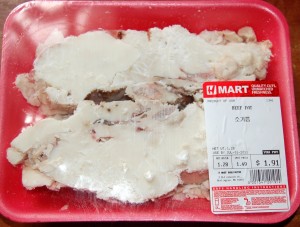
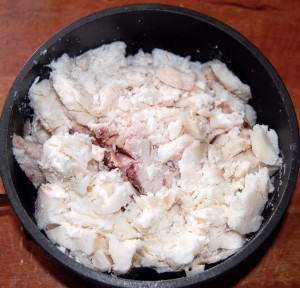
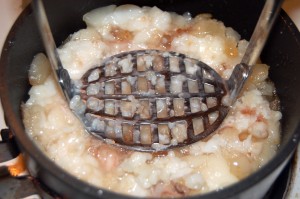
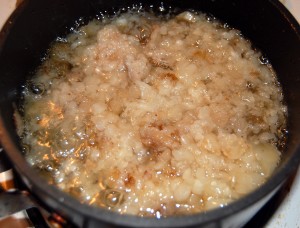
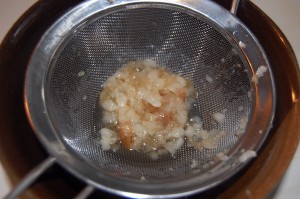
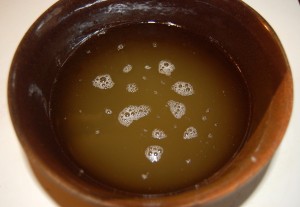
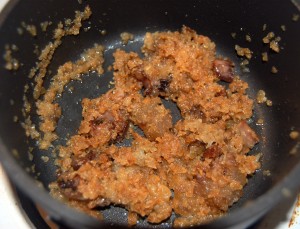




Cracklings are the equivalent of culinary crack. Irresistible. 🙂
I also render beef tallow but generally follow Mark Sisson’s method, which is a dry render using just one heating. The leftovers become an extremely tasty treat for my dog.
I get the fat from the butcher that cuts my sides of grass-fed beef. Nobody wants the suet, so I can have as much as I want. If the beef was harvested in spring or summer the fat is a wonderful light yellow (extra carotenes I think) and the tallow is somewhat softer when refrigerated, perhaps because it has a lower saturated fat content.
I find tallow to be an excellent cooking oil.
Very interesting fractioning off different oils, never did that personally. As a kid we’d get cracklings or “crispies” free from fish n chip shops (Scotland). Unfortunately European laws now often require’veg’ Oils instead of lard and tallow. Doesn’t appear to be helping public health stats either 🙂
Interesting. Just how unhealthy are those cracklin’s? We sprinkle ours with salt and cinnamon, freeze them and pull them out for a tasty dessert from time to time. Never occurred to me that there was anything unhealthy about them.
Hi Eric,
Just precautionary on our part. What’s healthy about them? We like our protein fresh.
How long will it last in the fridge, also save my bacon fat for cooking, any pros and cons of the two? Thanks Ted
Ted,
Bacon fat has a less saturated fat (39% vs 50%) and more monounsaturated fat (45% vs 42%) and PUFA (11% vs 4%).
Paul,
Great post, thanks! But, I, on the other hand, will continue making ghee… I know, it’s more expensive, but has some advantages: waay is more palatable and has some K2!
Hi Ted,
It should last a long time. Weeks at least.
Beef fat is a bit healthier for the reasons Mario gives.
Hi Mario,
Ghee is great too, especially if you get the butter from pastured cows.
Great post! I usually render my own tallow but I use the low setting on the slow cooker and leave it for 12 hours… not sure if that’s damaging the low-melting-temperature fats though.
It looks like you are getting fat from conventionally-raised cows. Are you concerned about potential toxins in the fat?
Hi Evan,
A bit … Antibiotics and other things are undesirable.
Grassfed pastured cows would be better, but we’d have to go to the Internet to find the fat I think. I haven’t seen good data on toxin levels in conventionally-raised cows and I’m not sure how concerned I should be. Animals like humans are constantly detoxifying themselves, so the cows aren’t as toxic as their diets and we can handle low-level residual toxicity.
Paul,
Very interesting about different melting points — will use your technique next time I render. By the way, when I’ve done, I’ve added diced rosemary, oregano, and turmeric to protect the fat from oxidation. All are fat soluble antioxidants and somewhat heat stable (much more than vit E).
Thanks Paul.
This is very helpful. I have to start doing this as coconut oil is getting too expensive.
So, you are not concerned with excess omega 6 from conventionally raised cows? It’s almost impossible to get pastured here…
Hi Daniel,
Thanks for the tip!
Hi Mia,
Omega-6 is low even in conventionally raised cows.
Looks wonderful! I’m sure I’d grab my salt shaker and enjoy the cracklings.
Paul:
I always wet-render (with added water): the rendered fat comes out much cleaner and lighter-tasting. Dry-rendered tallow makes everything taste like a hamburger to me.
It’s really easy to do: simply boil it once until nothing more comes out of the fat chunks, and strain it as you’ve shown. Put the liquid in the refrigerator, and you’ll end up with a solid disc of tallow atop some liquid water. Then, just punch two holes in the disc of tallow, one in each end, and pour the water out from underneath. Done!
JS
I have a big bag of grass fed beef tallow that I need to render. perfect timing! Next time we meet up, Paul, I will bring a jar of it for you and Shou-Ching. Straight from the Texas Panhandle 🙂
Hi JS,
Thanks. It sounds a little better than the method we tried. However, Shou-Ching thinks the wet method takes longer. She’s very much into speedy cooking.
Hi Emily,
Great! We’ll do a side-by-side with the store bought fat and see how the taste compares.
Last week for lunch one day I pan-fried a hamburger patty on med-low heat and fried a thick-sliced potato in the rendered fat.
The potato slices fried to a nice golden brown were crispy on the outside and mucho tasty.
Hi Jim,
Coming this Sunday: French fries prepared in beef tallow.
Hi Paul,
You should try, someday, the “brazilian version” of french fries: mandioca frita (fried cassava/manioc/yuca)!
http://bewitchingkitchen.com/2010/01/17/mandioca-frita-101-fried-yucca-root/
Great stuff. When I first found The Primal Blueprint I ate a heck of a lot of veggies cooked in beef tallow. I eat less beef tallow now, but it is still important to me, especially since I can’t find good butter for my mashed potatoes.
I know the importance of eating animal fat but aren’t toxins, hormones, antibiotics, etc. stored in the fat? So isn’t it important to only eat grass-fed, pastured animal fat and avoid conventionally-raised animal meat/fat if possible?
P.S., especially when conventionally raised animals are fed all of that corn and soy garbage
Here in the UK, we can buy blocks of what is labelled “Beef dripping” which I guess is rendered beef fat: it’s a solid white fat. Do you render your own fat because supermarkets don’t sell “beef dripping” in your neck of the woods or for some other reason?
Hi Kaitlyn,
It’s preferable to eat grass-fed pastured animals. In conventionally raised animals most are still healthy, toxin levels are low, and the fat is still healthy to eat; but there is more variability and risk.
It is difficult to judge the risk associated with low doses of toxins. I think the evidence is inconclusive about whether the toxin levels in conventionally-raised beef have a health effect. They might.
Re your PS, they do a pretty good job of detoxifying corn and soy. They suffer from the toxins, but we don’t.
Hi Paul,
Yes, I haven’t seen “beef dripping” here.
There are no pastured cows in Greece, so I’m not inclined to make tallow. Plus, I’ve got access to coconut oil and I can get ghee from pastured goats (it’s the only way they make it), so there’s really no motivation too work so hard for another option! Goat ghee is great stuff, btw (although my wife hates the smell).
I just did it! The butcher gave me the fat for free, and now I have a quarter of a liter of wonderful beef tallow. I didn’t expect it was so easy 🙂
Thanks a lot for this idea!
Congrats Paolo, not only cheaper but healthier than vegetable oil!
Thanks, I feel so well as I saved some healthy food from being rubbish (is it correct in english?)
We buy a pasture raised, heritage hog every year. I usually render the lard from that using the crockpot on low with water for 12 hours. Am I damaging the fat by doing it that way instead of emptying bit-by-bit?
Thanks!
Hi Angie,
No, I think that should be OK. I think the crock pot controls temperature so it won’t get too hot. While there’s water around, it’s guaranteed not to get too hot.
Paul,
What is the highest temperature you get up to, with your repeated process of fractioning off the oil, and then upping the temperature?
Many thanks,
Mike
(another Brit here who buys “beef dripping” in the supermarket, but who would love to render his own)
Hi Mike,
It’s hard to say because we didn’t use a thermometer, but we stay well below the smoke point, which is probably around 350 F.
Shou-Ching says it was all very fast, only very low heat on the stove, and so the highest temperature may have been 250 F at most.
I like to throw several small chunks of suet into a large, shallow roasting pan and put it in the oven at about 325 until the fat starts to render out and the cracklings turn a little brown. I take out the pan and, using a small ladle and tipping the pan so the fat gathers in the corner, remove excess fat to save for later use. Then I add slices or chunks, or fry cut pieces of butternut squash, salt and dried herbs, toss it together so all is nicely coated with fat and put it back in the oven for another 1/2 hour or so. Of course I eat the cracklings along with the squash. Divine! This works with all kinds of vegetables and you get your fat rendered at the same time.
Hey Paul, I was wondering if you could expand on cracklings being unhealthy, or point me in the right direction? It’s mentioned in this post and someone told me they read it in PHD, but I can’t seem to find it. Thanks!
There’s nothing in the book and we don’t know they’re unhealthy … it’s just a personal choice. They might be fine.
I have a strange question for Paul or anyone else with relevant experience. I have noticed dramatic health improvements after only a week of using a sleep mask. It’s really remarkable. For years I have slept in apartment rooms that let in a ton of light from the outside, but I now want to buy some blackout curtains (the sleep mask can be a little bit uncomfortable when trying to fall asleep). Has anyone had a positive experience with a specific brand of blackout curtains? I gather there is a lot of variability in the quality.
Ah, I put this under “Beef Tallow” rather than FAQ. I will repost in the right area.
love the vast amount of info on this website, and I’m looking forward to the December release of your upcoming book.
I was wondering if you or anybody else had any info regarding how the body processes tallow & lard? I mean, I know they’re more nutritious (cheaper to boot,) but do they make the body more acidic or cause inflammation compared to coconut or olive?
Hi Michael,
They don’t make the body acidic, and they are only inflammatory on an energy-excess diet that causes obesity. PHD is not such a diet.
Tallow is extremely healthy, lard is healthy if the pig was naturally raised but is too high in omega-6 if the pig was industrially raised.
Firstly, thank you so much for your work and your site! I just found it the day after Thanksgiving, and have been reading it non-stop ever since!
I often cook hamburger meat, and of course I drain off the fat as it cooks because I hate getting burned (and I’m not really interested in deep-frying my burgers). I have always just stored this in the cupboard until the container was full, then threw it away. Do you think if I were to refrigerate these drippings, they would be OK to use the same as beef tallow (since they probably see a bit higher temps than tallow rendered via this method)? I do spice my burgers, so it wouldn’t be as flavorless as tallow, but I’m thinking those spices would add some great flavor to certain dishes…
Thanks again,
Michelle
Hi Michelle,
Yes, you can re-use the hamburger fat as a cooking oil. If you won’t re-use them within 3-7 days, you probably should render the oil as the protein and other organic meat molecules could allow them to go bad.
Thanks so much for your guidance! I have one followup question (semi-unrelated):
I am packing my husband’s lunches, and trying to raise the amount of good fat we’re both eating (up until I found your site we were both very low carb, and pretty high protein). I know fats have more calories than carbs & protein, so they add up quicker, but I’m still struggling to get my ratio up where the PHD recommends. And of course when I search around for tips on adding healthy fats, or even sat fats, all I can find is advice on how to raise PUFAs and lower sat fats.
Where can I find suggestions on how to add more fats to our meals, especially the ones I pack for him (he has a microwave at work, so thankfully they don’t have to be cold)?
Thanks again,
Michelle
Hi,
Just wondering, can you use the fat that rises to the surface when making stock with beef bones, or is it bad because of being cooked for a long time?
thanks for all your work,
Deedee
Hi Deedee,
When we make stock, we do a very quick simmer and discard this — it often releases a brown scum which smells unpleasantly — and then do a second simmer for about 3 hours which releases most of the fat from the bones. This we separate and use for Pho. I think it is good to eat this, as long as it is not cooked too long, as there is a danger that prolonged cooking can generate rancidity.
Then we add more water and re-use the bones for more broths that are less fatty. We’ll typically re-use the bones ~5 times, usually with a 3-4 hour simmer and only just enough water to cover the bones in a small ceramic pot.
Many thanks for the prompt response, Paul. I’ve been cooking the stock much longer (24 hrs. at a simmer). Will try your method.
Hi Deedee,
Here’s a fuller description of our method, with pictures: http://perfecthealthdiet.com/2011/10/bone-broth-revisited-and-pumpkin-soup/
RE: Flaxseed Oil
Hi Paul, thanks for your very interesting post on tallow! I’m going to look into this more for cooking.
I didn’t see any threads on flaxseed oil, so I’m posting my question here. In your book, you say to avoid vegetable seed oils. Does that include Flaxseed oil? I use it for salad dressing upon the recommendation of my doctor, because my body is low on alpha linolenic acid.
Thanks!
Hello,
I am still confused about how to reach 120-140 gr of lipids per day. I weight 48 kgs at 164 cm and I want to gain some weight back, but I can`t eat so much fat, not because I don`t like it, but because I don`t know how to include it in my meals. Any advice? Thank you.
Hi Kim,
First, petite women generally don’t need to eat so much fat. These are guidelines for a 2000 calorie reference diet, but not all persons need that much food, so you have to adjust quantities to your personal needs. Eating a higher fraction of carbs and protein will help with lean tissue gain. Your optimal diet may be closer to our “weight loss version”, http://perfecthealthdiet.com/2011/02/perfect-health-diet-weight-loss-version/ — in your case it would be a body recomposition version.
Cracklings – I like them. Our ancestors ate all the parts of the animal, especially prizing the fats. I’d be interested to learn if there’s nutritional information on them — mostly protein?